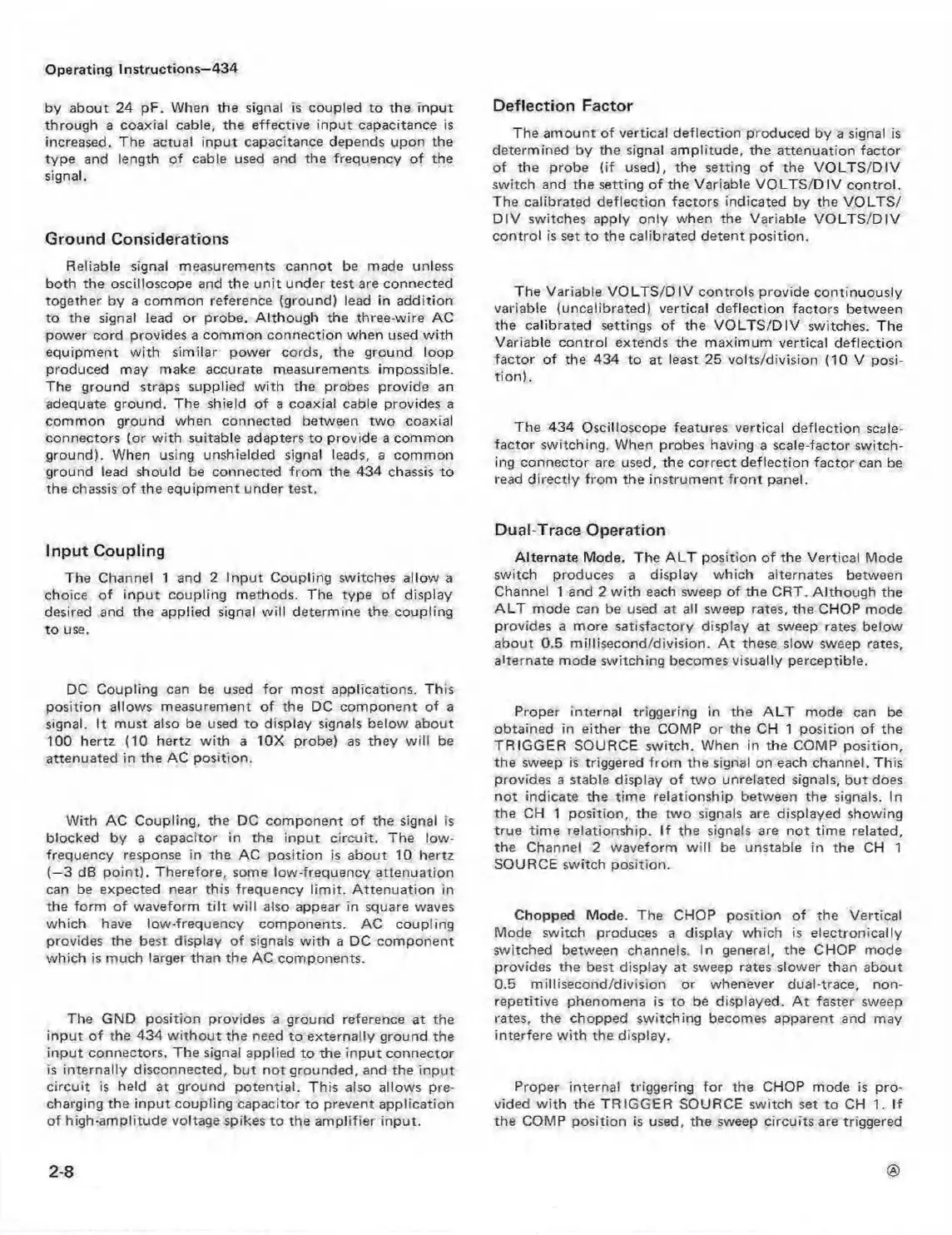Operating Instructions—434
by about 24 pF. When the signal is coupled to the input
through a coaxial cable, the effective input capacitance is
increased. The actual input capacitance depends upon the
type and length of cable used and the frequency of the
signal.
Ground Considerations
Reliable signal measurements cannot be made unless
both the oscilloscope and the unit under test are connected
together by a common reference (ground) lead in addition
to the signal lead or probe. Although the three-wire AC
power cord provides a common connection when used with
equipment w ith similar power cords, the ground loop
produced may make accurate measurements impossible.
The ground straps supplied with the probes provide an
adequate ground. The shield of a coaxial cable provides a
common ground when connected between tw o coaxial
connectors (or w ith suitable adapters to provide a common
ground). When using unshielded signal leads, a common
ground lead should be connected from the 434 chassis to
the chassis of the equipment under test.
Input Coupling
The Channel 1 and 2 Input Coupling switches allow a
choice of input coupling methods. The type of display
desired and the applied signal w ill determine the coupling
to use.
DC Coupling can be used for most applications. This
position allows measurement of the DC component of a
signal. It must also be used to display signals below about
100 hertz (10 hertz w ith a 10X probe) as they w ill be
attenuated in the AC position.
With AC Coupling, the DC component of the signal is
blocked by a capacitor in the input circuit. The low-
frequency response in the AC position is about 10 hertz
(—3 dB point). Therefore, some low-frequency attenuation
can be expected near this frequency lim it. Attenuation in
the form o f waveform tilt w ill also appear in square waves
which have low-frequency components. AC coupling
provides the best display of signals with a DC component
which is much larger than the AC components.
The GND position provides a ground reference at the
input of the 434 w ithout the need to externally ground the
input connectors. The signal applied to the input connector
is internally disconnected, but not grounded, and the input
circuit is held at ground potential. This also allows pre
charging the input coupling capacitor to prevent application
of high-amplitude voltage spikes to the am plifier input.
Deflection Factor
The amount of vertical deflection produced by a signal is
determined by the signal amplitude, the attenuation factor
of the probe (if used), the setting of the VO LTS /D IV
switch and the setting of the Variable V O LT S/D IV control.
The calibrated deflection factors indicated by the VOLTS/
DIV switches apply only when the Variable V O LT S/D IV
control is set to the calibrated detent position.
The Variable V O LTS/D IV controls provide continuously
variable (uncalibrated) vertical deflection factors between
the calibrated settings of the V O LTS/D IV switches. The
Variable control extends the maximum vertical deflection
factor of the 434 to at least 25 volts/division (10 V posi
tion).
The 434 Oscilloscope features vertical deflection scale-
factor switching. When probes having a scale-factor switch
ing connector are used, the correct deflection factor can be
read directly from the instrum ent fro nt panel.
Dual-Trace Operation
Alternate Mode. The A LT position of the Vertical Mode
switch produces a display which alternates between
Channel 1 and 2 with each sweep of the CRT. Although the
A LT mode can be used at all sweep rates, the CHOP mode
provides a more satisfactory display at sweep rates below
about 0.5 millisecond/division. A t these slow sweep rates,
alternate mode switching becomes visually perceptible.
Proper internal triggering in the A LT mode can be
obtained in either the COMP or the CH 1 position of the
TRIGGER SOURCE switch. When in the COMP position,
the sweep is triggered from the signal oh each channel. This
provides a stable display of tw o unrelated signals, but does
not indicate the time relationship between the signals. In
the CH 1 position, the two signals are displayed showing
true time relationship. If the signals are not time related,
the Channel 2 waveform w ill be unstable in the CH 1
SOURCE switch position.
Chopped Mode. The CHOP position of the Vertical
Mode switch produces a display which is electronically
switched between channels. In general, the CHOP mode
provides the best display at sweep rates slower than about
0.5 millisecond/division or whenever dual-trace, non-
repetitive phenomena is to be displayed. A t faster sweep
rates, the chopped switching becomes apparent and may
interfere w ith the display.
Proper internal triggering for the CHOP mode is pro
vided w ith the TRIGGER SOURCE switch set to CH 1. If
the COMP position is used, the sweep circuits are triggered
2-8

